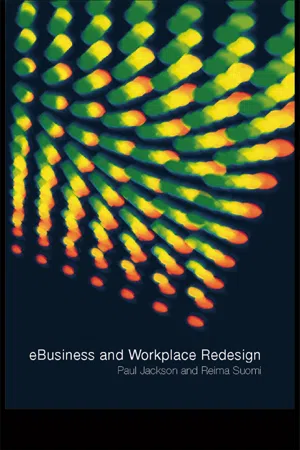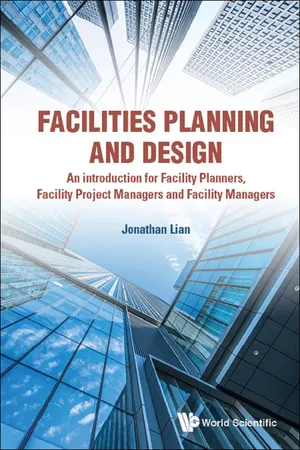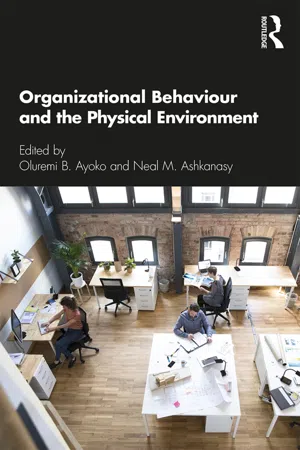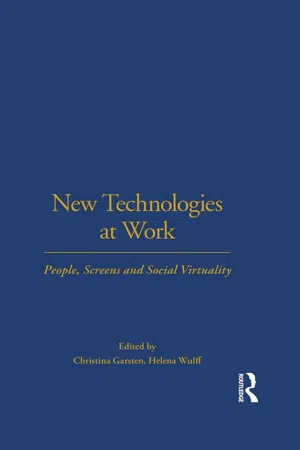Technology & Engineering
Office Design
Office design refers to the planning and arrangement of physical spaces within a workplace to optimize productivity, comfort, and collaboration. It involves considerations such as lighting, furniture, layout, and technology integration. Effective office design can improve employee satisfaction, reduce stress, and enhance overall business performance.
Written by Perlego with AI-assistance
Related key terms
Related key terms
1 of 4
Related key terms
1 of 3
5 Key excerpts on "Office Design"
- eBook - ePub
- Paul Jackson, Reima Suomi, Paul Jackson, Reima Suomi(Authors)
- 2003(Publication Date)
- Routledge(Publisher)
Nowadays, the physical place of the company is changing in size, dimension, features and location. Crucial to these changes has been the contribution of network communications, including road and train networks, as well as IT. However, the design of office buildings has often failed to meet the needs of the organisations that use them. The speculative nature of much office development has encouraged design focused on maximising economy and flexibility of space. In addition, even when a particular client has been directly involved, the design is often focused on corporate image expressed in reception spaces and façades. Finally, the very shape and design of the office building has been heavily restricted by planning legislation. The introduction of new technologies in the office has changed the expectations of users relating to new processes and tasks. The idea of an individual workplace within the office, or of one seat per person, has been challenged (Worthington 1997).While the new technologies have provided new work possibilities, realizing these must take careful consideration of how individual and team areas are created, with the main objective being to support social contact between individuals. The concepts involved in the new ways of working—which are premised on the exploitation of new technology and encourage work to be carried out when and where it is most suitable—have been combined with ideas about simplification that permit flexibility and cost control (Eley and Marmot 1995). As Eley points out, these principles are reflected in a number of common terms used today in space planning: for example: ‘quiet rooms’, ‘war rooms’, ‘project rooms’, ‘team areas’, ‘group bases’, ‘work lounges’ and so on. All apply to spaces used by people for different tasks at different times and in different combinations. - eBook - ePub
Facilities Planning and Design
An introduction for Facility Planners, Facility Project Managers and Facility Managers
- Jonathan Lian(Author)
- 2018(Publication Date)
- WSPC(Publisher)
ART 3Workplace Planning and DesignPassage contains an image
CHAPTER 9
Workplace Planning and Design
In this chapter, you will learn about the following: 1.Key trends that are driving change in organisations and the workplace 2.Changes in workspaces, meeting spaces, support spaces and technology 3.Essential #9 – Considerations that must be taken in the planning and design of offices 4.Challenges in implementing a new office concept 5.Coworking spacesEssential #9Understand the considerations in the planning and design of workplaces.The previous chapters considered planning and design at large scales (e.g. building scale and campus scale). This chapter considers planning and design at a smaller scale, specifically office spaces. This chapter also seeks to help the reader consider planning and design in the context of a particular type of facility — offices.Many people spend at least forty hours a week at their workplace. This accounts for a substantial portion of their time. Hence, it is important that their workplaces are well-planned and well-designed. Another reason is that the layout and design of the workplace can affect a worker’s productivity and job satisfaction.This chapter will focus on workers in an office setting as this is the situation that is most typical. The layout and design of an office is determined by the organisation whose employees occupy the office. The organisation’s activities also drive the layout and design of the office.9.1Key trends driving change in organisations and the workplace
According to the Whole Building Design Guide (WBDG) (2017) there are three key trends that are driving change in organisations and the nature of work:•Globalisation and increased competition. •The Information and Communications Technology (ICT) revolution. •The increasing pace of change resulting from increased competition and the technology revolution.Globalisation has brought out enhanced competition which has led to companies needing to become leaner. Organisations strive to be ‘lean’ in a drive to become more competitive, agile and focused on the customer. - Oluremi B. Ayoko, Neal M Ashkanasy, Oluremi B. Ayoko, Neal M Ashkanasy(Authors)
- 2019(Publication Date)
- Routledge(Publisher)
Regarding the impact of Office Design on work processes and performance, this influences the individual employee. However, this aspect of Office Design operates and shows at a group level. The office environment and the work process should match – meaning that the office layout, to improve productivity, must complement the work process of organization, for example by an office layout that facilitates the workflow (see reviews in Al Horr et al., 2016; Haynes, 2008). In fact, there is even an Office Design – lean Office Design – that is designed with this purpose only (Bodin Danielsson, 2013).The office layout affects behaviour in the workplace in different ways. Thus, an office layout focused on the process of the organization can support this in various ways. At a group level, for example, by focusing on teamwork and interaction, visual contact and meetings between different groups and departments can be enabled. At an individual level, the balance between distraction and stimulation in the design of the plan layout is the focus, as this is crucial for the individual’s productivity in terms of, for example, writing and calculating (e.g. Keus van de Poll & Sörqvist, 2016; Maher & von Hippel, 2005). This is important as distraction has the most negative impact on employees’ perceived productivity, while at the same time in many cases interaction is the most positive (Haynes, 2008), and both are largely determined by the plan layout of the office. Work assignments and needs related to these vary depending on the job and occupational position; people also have different personalities and needs related to these. Nevertheless, research has found that in most cases, to work efficiently, office employees need an office that enables distraction-free work, but also informal interaction with colleagues (Heerwagen, Kampschroer, Powell, & Loftness, 2004). In line with this, a case study of two ‘innovative’ offices, designed to enhance creativity, found that spaces for communication and interaction, but also for privacy, are crucial (Haner, 2005).Architectural elements and design featuresThere are some indications architectural design regarding aesthetics and colour schemes in indoor environments could affect performance and productivity (Mahnke, 1996; Özturk, Yilmazer, & Ural, 2012). Foremost, physical features such as spatial diversity within the office have positive influences on this (Ehler et al., in Haner, 2005). This includes for example a division into different zones in terms of activities and needs related to these, for example a division into an action zone, an interaction zone and a retreat zone (see Bauer, Haner & Rieck, 2001, in Haner, 2005). Of interest here is that accessibility of a mixture of office types within the office appears to correlate with employees’ rating of ‘motivation’, ‘attractiveness of the work environment’, ‘wellbeing’ and rating of ‘office performance’ (Ehler et al., in Haner, 2005). With regard to creativity, we know that a supportive social–organization work environment and positive mood motivate creative behaviour and facilitate the generation of more ideas (Amabile et al., 1996; Davis, 2009; Isen, Daubman, & Nowicki, 1987). It has been hypothesized that the physical environment can enhance creativity (Amabile et al., 1996, p. 249), and there have also been some attempts to identify design features that enhance this. In a study by Dul and Ceylan (2010), office employees were rated on elements in their social–organizational and physical work environment, and whether this correlated with employees’ self-rated creative performance. They found that high rates of creative work environment correlated with high rates of creative performance.- eBook - ePub
Human Factors and Ergonomics for the Gulf Cooperation Council
Processes, Technologies, and Practices
- Shatha N. Samman(Author)
- 2018(Publication Date)
- CRC Press(Publisher)
The literature of environmental design and their respective evidence-based design principles are characterized by three key concepts: variability, adaptability, and greenery. Variability affects occupants with a range of differences in personal capabilities and behaviors (i.e., gender, age, ethnicity/cultural differences), time variability, and body and mental modifications occurring at different stages of life. Work demands and tasks are changeable, requiring increased creativity and decision-making abilities. Technology’s pervasiveness is removing all barriers between work and personal life, such that physical and social factors are blending with almost intangible spaces that are pervading our quality of life. Adaptability in environmental design is expressed in different ways: via behavioral and cognitive personal controls; achieved through design solutions allowing occupants direct action over the environment with easy interpretation of spatial and temporal situations and events; by physical settings that are adjusted and personalized; and by offering opportunities for users to be empowered by active participation in the design process. Lastly, environmental design needs to be green-oriented to improve the health and restorative effects of nature to occupants. Spaces should have an open surrounding with pleasant outside views of green elements that allow access of natural light and natural ventilation, and with the placement of operable windows.Key termsBuilding and architectureThe term building refers to any human-made structure used or intended for supporting or sheltering any use or continuous occupancy. In a broader meaning it indicates not only a structure that has a roof and walls and stands more or less permanently in one place, but also its inside and outside designed spaces. It is one of the main elements of the built environment. Architecture is the art or practice of designing and building edifices and other elements of built environment for human use, taking both aesthetic and practical factors into account. It is the process of creating buildings and spaces that motivates occupants that facilitate them to do their jobs, that bring people together, and that become, at their best, works of art that people can move through and live in. - eBook - ePub
New Technologies at Work
People, Screens and Social Virtuality
- Christina Garsten, Helena Wulff(Authors)
- 2020(Publication Date)
- Routledge(Publisher)
place – or both. Crucially, the outcome depends on the details of the spatial, technological and social interventions. In the case of JFC’s office, technologies were involved in both of the design strategies; they fostered local interactions as well as flexibility and mobile flows. Yet, due to the specifics of the design and use of technologies in the office, the results tended to weaken the more collaborative and team-based social forms and strengthen the flows of people and individualized forms. In JFC’s Office Design, technology privileged transience and anonymity, re-established individual resource handling, and reintroduced individual ownership. Yet, it could have been otherwise.Conclusion
Interwoven in this chapter were two interconnected lines of inquiry: a close analysis of a particular Office Design that included a reflection on the dialectic tension between individualized and social ways of working, and an exploration of the pivotal role of technology and spatial principles for forms of social organization at work.The central topic was the description and analysis of the self-experiment of innovative Office Designers who developed for themselves what they considered a showcase state-of-the-art office. I presented this experiment as an informative case of organizational engineering, where spatial and technological design strategies together with certain behavioural rules were meant to enable, encourage, or even enforce specific work styles, social structures and organizational characteristics. I argued that there were not one but two distinct organizational visions embedded in the design. Built around principles of proximity, open space and informal encounters, one vision aimed at increasing communication, teamwork, collective ways of organizing work, and a communal and social climate. The other design vision deployed principles of non-territoriality and multiple work settings together with an elaborate system of mobile technologies to achieve flexible work patterns, mobile ways of working and a more fluid, dynamic and responsive organization. I argued that in practice these two visions could be in conflict, where the mobile and flexible design efforts worked against some of the goals of a more communicative and collaborative organization.
Index pages curate the most relevant extracts from our library of academic textbooks. They’ve been created using an in-house natural language model (NLM), each adding context and meaning to key research topics.
Explore more topic indexes
Explore more topic indexes
1 of 6
Explore more topic indexes
1 of 4




